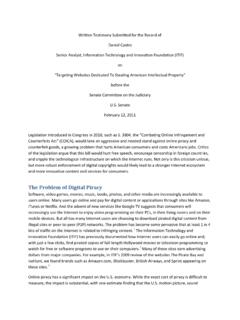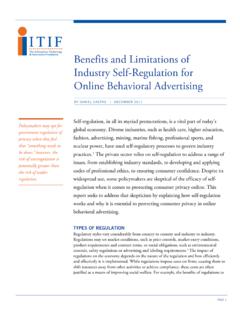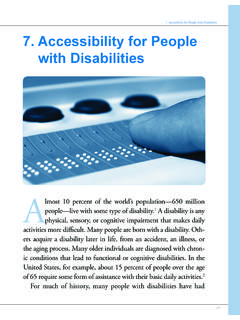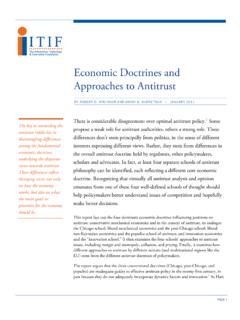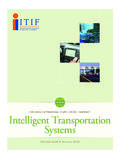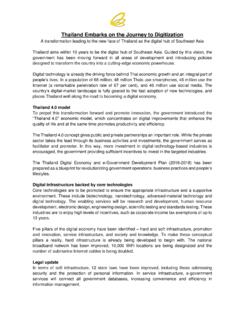Transcription of EXPLAINING INTERNATIONAL IT APPLICATION …
1 Electronic IdentificationE XPL AINING INTERNATIONAL IT APPLICATION LE ADERSHIP:D a n i e l C a s t r o | S e p t e m b e r 2 0 1 1 EXPLAINING INTERNATIONAL Leadership: Electronic Identification Systems BY DANIEL CASTRO SEPTEMBER 2011 PAGE II THE INFORMATION TECHNOLOGY & INNOVATION FOUNDATION | SEPTEMBER 2011 ITIF ALSO EXTENDS A SPECIAL THANKS TO THE SLOAN FOUNDATION FOR ITS GENEROUS SUPPORT FOR THIS SERIES. SEPTEMBER 2011 PAGE III THE INFORMATION TECHNOLOGY & INNOVATION FOUNDATION | SEPTEMBER 2011 TABLE OF CONTENTS Executive Summary .. V 1 Background .. 1 Box 1: Electronic Passports .. 3 Terminology and Technology .. 3 Electronic Signatures, Digital Signatures and Digital Certificates .. 3 Identification, Authentication and Signing .. 4 Benefits of e-ID Systems .. 5 Electronic Identification Systems: Deployment and Use.
2 6 Country Profiles .. 9 Austria .. 9 Belgium .. 10 Denmark .. 12 Estonia .. 13 Malaysia .. 16 Norway .. 18 Sweden .. 19 Turkey .. 21 United States .. 21 Box 2: Federal Government Electronic Identity Management Efforts .. 22 Lessons from Early Adopters .. 25 Legal Framework for Electronic Signatures .. 26 Cultural and Historical Factors .. 30 Country Demographics .. 30 National Registries .. 31 National Identification Card .. 32 Organizational Issues .. 33 The Degree of Centralization or Decentralization .. 33 Entity Leading the Design and Implementation .. 33 Policy Issues .. 34 Replacement of Existing ID Cards .. 34 Government Programs to Spur Demand and Increase 34 PAGE IV THE INFORMATION TECHNOLOGY & INNOVATION FOUNDATION | SEPTEMBER 2011 Public or Private Solution .. 35 Technology 37 Form of e-ID .. 37 Open Platform .. 38 Use of Biometrics.
3 38 Interoperability .. 39 Affordability of e-ID Card .. 39 Privacy .. 41 Privacy-Enhancing Policies .. 42 Privacy-Enhancing Technologies .. 43 Recommendations for the United States .. 46 Create an e-ID implementation plan with broad input from all stakeholders, including the private sector .. 47 Build an e-ID framework that supports both current and emerging technologies .. 48 Use government to increase both supply and demand for e-IDs .. 48 Design an e-ID solution that maximizes utility for both users and service providers .. 50 Ensure that privacy does not come at the expense of eliminating useful information from the information economy .. 52 Strive for disruptive innovation, not just incremental innovation .. 52 Ensure that e-ID solutions are accessible and available to all individuals .. 53 Design an e-ID system for the global digital economy .. 54 Endnotes.
4 55 Acknowledgements .. 56 About The Author .. 56 About ITIF .. 56 PAGE V THE INFORMATION TECHNOLOGY & INNOVATION FOUNDATION | SEPTEMBER 2011 EXECUTIVE SUMMARY Identification is routinely used to help facilitate commercial and government transactions, such as taking out a loan or applying for government benefits. While individuals can use traditional forms of identification in face-to-face transactions, these forms of identification are less useful for conducting business on the Internet. To address this challenge, many governments are creating national electronic identification (e-ID) systems a collection of technologies and policies that enable individuals to electronically prove their identity or an attribute about their identity to an information system. This report reviews the programs and practices of some of the countries with the most advanced and widely deployed national e-ID systems.
5 It highlights the successes and failures of different approaches and focuses on the lessons that policymakers, particularly in the United States, can learn from nations that have begun adopting and using e-ID systems. National e-ID systems offer a variety of benefits for individuals, businesses and governments. These systems can help reduce identity theft and enable individuals to use online applications more securely in a variety of industries such as health care and banking. Individuals can use an e-ID to authenticate to online services, securely communicate online, purchase goods and services, and create legally-binding electronic signatures, such as to sign a contract. Businesses can use identity management functions to better interact with their customers on the Internet, such as to authenticate users to online applications or to verify the ages of their customers.
6 Finally, government can use e-IDs to streamline e-government services, allow individuals to sign and submit forms online, and offer innovative services. Many European countries have been investing in national e-ID systems, as have countries in the Middle East and Asia. While no country has achieved universal deployment and use of a national e-ID system, some countries have made more progress than others. At present the clear leader is Estonia, which has issued approximately million e-ID smartcards to an eligible population of million citizens ( individuals age fifteen and older). Since inception, cardholders in Estonia have used their e-ID to create more than 52 million electronic signatures and authenticate more than 88 million electronic transactions. Estonia has even used its e-ID system to allow citizens to vote online. In contrast, as of 2011, the United States does not have a national e-ID system.
7 Most individuals still use a collection of poorly secured usernames and passwords to access online PAGE VI THE INFORMATION TECHNOLOGY & INNOVATION FOUNDATION | SEPTEMBER 2011 services and, more than a decade after Congress passed the Electronic Signatures in Global and National Commerce Act (ESIGN), most individuals never use secure electronic signatures to sign documents. However, the federal government recently launched the National Strategy for Trusted Identities in Cyberspace (NSTIC), a new initiative to develop an online identity ecosystem. Policymakers have many opportunities to learn from the countries furthest along in deploying e-ID systems as they shape the technology, institutions and policies that will guide e-ID development in the United States. Countries have many options for building an e-ID system, and each country can design a system to address its unique needs.
8 While demographic, cultural and historical factors may influence a country s national e-ID strategy, and existing ID infrastructure such as national registries may make deployment easier, all countries appear able to take advantage of this technology. Although the United States is late in creating a national e-ID strategy, if it heeds the lessons from early adopters it can capitalize on an enormous opportunity to create an e-ID system that can leapfrog those of other countries and help invigorate our information economy. Therefore, to promote e-ID adoption and use in the United States, policymakers should do the following: Create an e-ID implementation plan with broad input from all stakeholders, including the private sector. The government cannot build a successful national e-ID system without support from all stakeholders. The countries with the most widespread use generally have both public and private-sector applications utilizing the e-ID system and virtually every country uses the private sector to operate a portion of the e-ID infrastructure.
9 Moreover, the private sector has many resources that can be built on and is the current supplier of much of the identity infrastructure, such as certificate authorities, that will be used. Build an e-ID framework that supports both current and emerging technologies. The government should not specify any particular technology for e-IDs but rather establish a technology-neutral e-ID framework that allows both public and private-sector identity providers to issue e-IDs using the technology of their choice. Countries such as Austria that have not created a single national token, such as a smartcard, but rather have established a flexible framework for e-IDs, offer citizens more options for obtaining an e-ID. Use government to increase both supply and demand for e-IDs. T echnologies like e-ID systems exhibit strong network effects whereby the value of the technology grows as the number of users increases.
10 A critical mass is needed to create the right value proposition for private-sector service providers to rely on the technology; without that critical mass, systems that accept e-IDs will not develop. Government, at the federal, state and local level, should invest in the identity ecosystem to overcome this chicken-or-egg problem inherent in its creation. The countries that are further ahead in e-ID adoption and use have aggressively invested in e-ID technology in advance of market demand for the technology; the most successful countries have also coupled these investments with demand-side programs to spur PAGE VII THE INFORMATION TECHNOLOGY & INNOVATION FOUNDATION | SEPTEMBER 2011 use of the technology. Design an e-ID solution that maximizes utility for both users and service providers. One of the reasons that e-ID solutions have had slow adoption in many countries is that many of the security benefits of using e-IDs, compared to using one-off solutions, have been one-sided: service providers use e-IDs to verify the identity of users, but users do not have the opportunity to verify the identity of the service providers.

